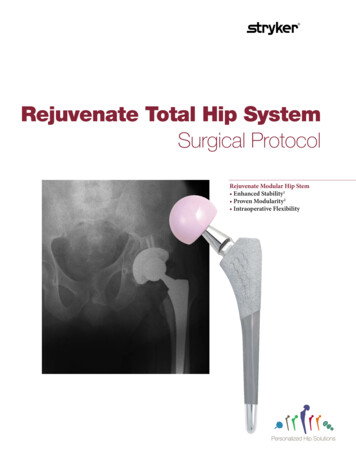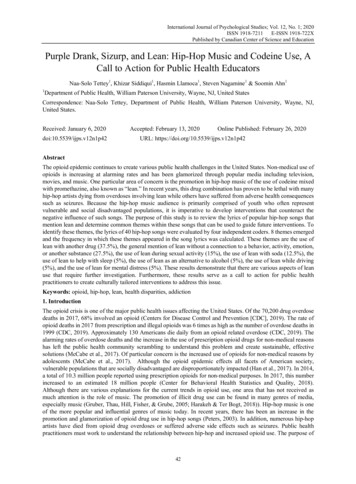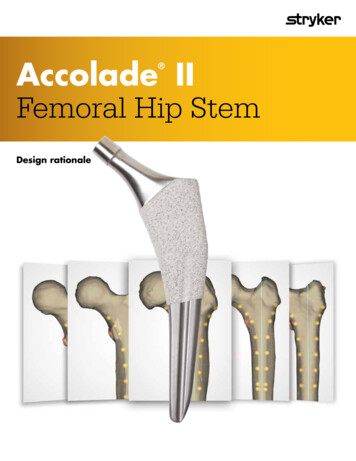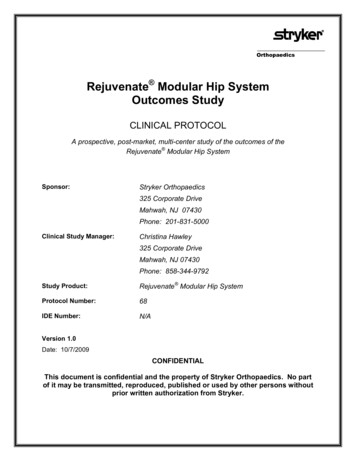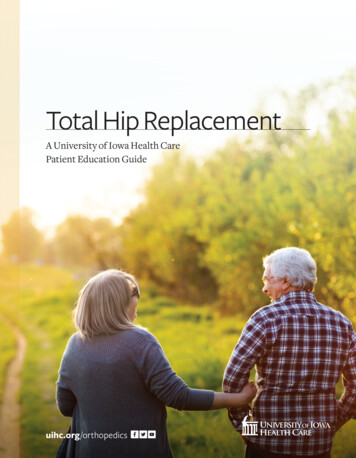
Transcription
Total Hip ReplacementA University of Iowa Health CarePatient Education Guideuihc.org /orthopedics
2 University of Iowa Health CareTotal Hip ReplacementPatient Education GuideThis book is meant to help you get ready for and recover from your total joint replacement surgery.Please read through it, and share the information with your family and/or caregiver. We want tomake sure you have the information you need for the best results possible, and that your hospitalstay and rehabilitation are as comfortable and effective as they can be.This book is full of guidelines and recommendations. Places in the book that are shaded gray haveindividualized information just for you. Please be sure to follow your doctor’s orders first. If any ofthe information here does not match your doctor’s instructions, please ask questions to make sureyou are getting the right care for you.Important appointments.4Your surgery at UI Hospitals & Clinics.5What is total hip replacement?.6Getting yourself ready for surgery.9Tips to make your home safe.12Your surgery checklist.13Staph screening and showering before surgery.14Day of surgery.17Leaving the hospital.20Incision care.23Rehabilitation following total hip replacement.25Home recovery.26Walking with a walker or crutches.28Hip precautions.29Occupational therapy (OT) .31Adaptive equipment: Getting dressed .32Life after joint replacement surgery.34Medication reminders before surgery .35Content Review: 05/09/2018
Total Hip Replacement Patient Education Guide 3Thank you!Thank you for choosing University of Iowa Hospitals & Clinics and the Department ofOrthopedics and Rehabilitation for your joint replacement surgery. You are an important partof the health care team, and we hope this guide will help answer your questions about what toexpect. This guide and the Total Joint Patient Education Class will help you plan your activitiesbefore, during, and after your surgery.Have someone in mind to be your helper and coach for your hip surgery. This person should joinyou for class to learn how they can help you when you get home. Keep this guide with you for yourappointments and while you are in the hospital.Please write down any questions you have and bring them with you to the joint class. Please call usif you have any questions after your pre-op visit and your Total Joint Class.We look forward to helping you get back to a healthy and active life.Sincerely,The Total Joint Replacement TeamUniversity of Iowa Hospitals & ClinicsDepartment of Orthopedics and Rehabilitation
4 University of Iowa Health CareImportant AppointmentsYou need to be seen by your dentist within 6 months before your surgery. All dental work needs tobe done before your surgery. You do not need to see your dentist if you do not have any of youroriginal teeth. Fax your dental clearance to 319-353-6754.Requesting time off work, FMLA and/or disability forms:Please fax your requests to the Orthopedic Insurance Office at 319-384-8487. Call 319-356-4627if you have any questions.Prior Authorization:Any questions for your upcoming surgery, please call the Orthopedic Prior Authorization Officeat 319-353-6240.You will have several appointments before your surgery. We have set up the following timesfor you:Total joint replacement class:Department of Orthopedics (Elevator I, Lower Level)Preanesthesia (if needed):Preanesthesia Clinic (Elevator F, Level 1)Medical clearance:Medicine Specialty Clinics (Elevator L, Level 3)Surgery Date:Surgery Check-In (Main Operating Room - Elevator H, Level 6 or Ambulatory Surgery Center(Elevator L, Level 4)A member of the anesthesia team will call you a few days before surgery. They will tell youthe time of your surgery and when to check in. Call 319-384-8039 if you have not heard fromanesthesia by 7 p.m. the night before your surgery.If you have questions, please call your surgeon’s office and talk with their assistant or theteam’s nurse.
Total Hip Replacement Patient Education Guide 5Your Surgery at University of IowaHospitals & ClinicsDriving Directions To get turn-by-turn directions toUniversity of Iowa Hospitals &Clinics, go to uihc.org and click onYour Visit.Parking InformationSelf-parking Ambulatory Surgery Center(Pomerantz Family Pavilion): Park inRamp 4 Main Hospital Operating Room:Park in Ramps 1, 2, or 3 The skyway to the hospital fromParking Ramp 3 is on Level 3 of theparking ramp Parking rates in the ramps will apply;for rate information, go to uihc.org andclick on Your Visit.Valet Parking Pomerantz Family Pavilion (forAmbulatory Surgery Center): 6:30 a.m.to 5 p.m. Monday through Friday Main Entrance (for Main OperatingRoom): 6 a.m. to 7 p.m. Mondaythrough Friday A flat rate is charged and can bepaid with cash, check, MasterCard,Discover, or Visa.
6 University of Iowa Health CareWhat is Total Hip Replacement?Total hip replacement is a surgical procedure to replace the hipjoint. This joint has two parts: Hip socket (acetabulum) often called the “cup” “Ball” or top of the thigh bone (femur)The bones of the normal hip form a ball and socket joint. Thesocket is part of the pelvis bone. The ball is the upper part orhead of the thigh (femur).During the surgery, these two parts of the hip joint are removed.They are replaced with smooth, artificial surfaces. The artificialsocket is made of a high-density plastic liner. It includes a metalshell around it. The artificial ball is metal or ceramic. The stemis made of metal.Above: A metal-backed, high-density plastic socket and stainless metal ball with stem. These artificial pieces are put into thehealthy bones of your pelvis and femur.
Total Hip Replacement Patient Education Guide 7?Should I have totalhip replacement?When are totalhip replacementsan option?What can I expect froma total hip replacement?The total hip replacementis an elective surgery. It isnot a matter of life or death.You have other non-surgicalchoices. The decision to havethe surgery is not made by thedoctor. It is made by you, theperson who must accept therisks and complications thatmight happen. The doctormay suggest the surgery,but you should think aboutthe benefits and risks beforeyou choose to have surgery.You may want to talk withyour personal doctor aboutthe surgery, or get anotheropinion. Make sure all ofyour questions are answeredbefore you decide to havethe surgery. Please ask anyquestions you have that willhelp to make your decisioneasier. Ask any questions inorder to make yourdecision easier.Total hip replacements aremost often done for severearthritis. They also are donefor other diseases that causethe head of the femur to die.You doctor will most likelytalk with you about a total hipreplacement if: A total hip replacementprovides relief fromarthritis pain for mostpeople. You will have pain from thesurgery that will get betteras you heal. The pain you had from yourhip before surgery shouldbe nearly gone. You should be able to doyour usual activities afteryou heal. You may be able to do activesports or an active job. Your pain is bad enough tomake you change the wayyou do everyday things,such as work, recreation,and activities like walking,dressing, and making meals X-rays show advancedarthritis or collapse of thehead of the femurTalk with your doctor aboutyour goals. You will learnwhich precautions you needto take for your hip. You willdo these for the rest ofyour life.
8 University of Iowa Health Care?How long does anartificial hip last?What are the risks oftotal hip replacement?Optimizing yournutrition before andafter surgery A total hip replacement maylast 15 to 20 years. Research shows that anartificial hip usually lasts along time. If you are overweight orvery active, the risk of thehip wearing out is higher. The results of a secondsurgery are not as good asthe first. The risk of complicationsis higher if you need moresurgery on your hip.Total hip replacement is amajor surgery. Complicationsmay happen. The mostcommon complications arenot related to the hip andusually do not affect theresult of the surgery. If youhave complications from yoursurgery, you may need tostay in the hospital longerthan planned.In the months and weeksbefore surgery, you can helpget your body ready for thestress of the surgery by eatingfoods that are healthy andnourishing for your body. Eat: Plenty of fruits andvegetables Foods with high protein andlow fat A balanced dietComplications are: Blood clots in your legor lungs Urinary infections ordifficulty urinating Trouble with anesthesia Nerve or blood flowproblems to your legStay well hydrated and eatplenty of fiber before andafter your surgery. You maytake a daily multivitamin tohelp optimize your nutritionbefore surgery.Complications that affectthe hip are less common.The surgery may not be assuccessful if these happen: Dislocation of hip (ballpops out of socket) Infection in hip Loosening or other failureof the implant
Total Hip Replacement Patient Education Guide 9Getting Yourself Ready for SurgeryGetting ready for a total hip replacement starts several weeks before your surgery date. Goodhealth before your surgery is important. A strong upper body will help you use a walker, crutches,or cane after surgery. Doing exercises to strengthen your legs will help you recover faster.Quad Sets Sit or lie on your back with your leg straight. Tighten your quad (thigh) muscles on the front of your leg,trying to push the back of your knee downward. Hold this for 5 seconds then relax and repeat.Special Instructions Do not hold your breath. Do 1 set of 15 repetitions, 3 times a dayGlute sets Lie on your back with your legs straight. Squeeze your buttocks together. Hold this for 5 seconds then relax and repeat.Special Instructions Do 1 set of 15 repetitions, 3 times a day.Heel slides Sit or lie on your back with your legs straight (may benduninvolved knee if it is more comfortable. Bend your knee and slide your heel up to your buttocks. Straighten your knee to go back to the start position. Do this in a slow, controlled motion in both directions withyour knee moving straight up toward the ceiling.Special Instructions Do 1 set of 15 repetitions, 3 times a day.
10 University of Iowa Health CareHip abduction/adduction Lie on your back on a firm surface with your legs together. Move your leg out to the side, keeping your knee straight andtoes pointed straight up. Go back to the starting position.Special Instructions Keep both hips on the bed at all times. Do not arch your back. Do not hold your breath. Do 1 set of 15 repetitions, 3 times a day.Short arc quads/terminal knee extensions Lie on your back with the involved leg bent over a pillow,as shown. Straighten your leg at the knee. Hold this for 5 seconds then relax and repeat. Go back to the starting position. Do this in a slow, controlled motion in both directions.Special Instructions Keep both hips on the bed at all times. Do not hold your breath. Do 1 set of 15 repetitions, 3 times a day.Long arc quads Sit on a chair with your involved leg bent as far as possible. Straighten your leg at the knee. Go back to the starting position. Do this in a slow, controlled motion in both directions.Special Instructions Do 1 set of 15 repetitions, 3 times a day.
Total Hip Replacement Patient Education Guide 11Chair push-ups Sit in a chair with arms. Push downward with both hands, raising your buttocks offthe chair or seat. Use your arms to lift your body and not your legs. Go back to the starting position.Special Instructions Do 1 set of 15 repetitions, 3 times a day.
12 University of Iowa Health CareTips to Make Your Home SafeGeneral ConsiderationsBathroomBedroom Know where your pets areso you do not trip overthem. Always use your assistivedevice in the bathroomand bedroom to keepyour balance. Stay alert in poorly lit orunfamiliar places. Be careful in crowdedpublic places. Place a non-slip mat inthe shower. Use a walk-in shower,if possible. Use a bath bench orshower chair. Use a hand-heldshowerhead. Put a grab bar near thetoilet and in the shower. Store needed supplies in ashower hanger at waist level. Remove all clutter fromthe floor. Place a night light betweenthe bedroom and bathroom. Place a nightstand besideyour bed. Place items you use oftenin the top drawers ofyour dressers.Stairs and stepsLiving AreasKitchen Have lighting at both thetop and bottom of stairs. Put in a handrail the wholelength of the stairs. Keep the stairs free fromobjects and clutter. Place bright non-skid stripson the edge of steps. Keep floors free of clutter. Arrange furniture so thereare clear walking pathways. Remove all cords and rugs. Do not use low chairs orcouches (we recommenda seat height of at least20 inches). Remove all throw rugs. Have ample lighting. Put items you use often atcounter level. Make and freeze meals inadvance or arrange forfriends or a meal service tobring meals.
Total Hip Replacement Patient Education Guide 13Your Surgery ChecklistDo your home exercise program 3 times each day to improve your strength.Do not smoke.Do not bring your prescription medication to the hospital at the time of surgery.Make an appointment with your dentist for a check-up for your dental clearance letter.Make a plan for after surgery:Who can stay with you when you go home (24 hours a day)?Who can be your driver (to and from hospital, therapy, lab)?Where will you go for physical therapy if you need it?Where will you go to get your blood drawn if you need to?Borrow or buy adaptive equipment. Practice with it before your surgery. Examples are reacher,toilet riser, long-handled shoe horn, sock aid, and a tub bench. Insurance generally does notcover these items.Make changes to your home to improve safety, if needed:Put grab bars in bathroomFind housing for petsPut in handrails on stairsPick up throw rugsOn the night before surgeryShower as instructed.Do not eat anything after midnight. Only drink clear liquids after midnight.Pack a t-shirt, shorts, tennis shoes, and toiletries.Do not bring valuables, such as jewelry, to the hospital.Take off nail polish and artificial nails.Someone from the anesthesia staff will call you and tell you what time your surgery isscheduled and what time to come to the hospital. Your surgery may be delayed or cancelledif you are late. If no one has called by 7 p.m. the night before your surgery, please call us at319-384-8039.On the morning of surgeryTake medicines as instructed with sips of water.Shower and wash your body as instructed on the next pages.Bring this book with you to the hospital.Check in at the OR front desk ASC-Ambulatory Surgery Center (Elevator L, Level 4) Main Operating Room (Elevator H, Level 6)Bring something to help pass the time for you and your family.
14 University of Iowa Health CarePre-Operative: Chlorhexidinegluconate (CHG) ShowerHow to stop surgical site infectionsThis hospital is working hard to prevent infections. We will: Give you one bottle of CHG soap (contains chlorhexidine gluconate) at your appointment beforesurgery. You will need to shower with this soap the evening before and the morning of surgery.This soap will help make sure your skin is free of germs. Give you antibiotics (medicines to prevent infections) as needed. Closely watch things like your temperature and blood sugar.How should I shower using CHG?Please follow these instructions for both before-surgery showers:1. Use a clean wash cloth and clean towel.2. Remove all body-piercing jewelry, and leave it out until after surgery.3. In the shower wash your face with your regular soap and water first. Wash your hair as usualwith your normal shampoo.4. Rinse your body well to remove the soap and shampoo residue5. Use a wash cloth to clean your skin with the CHG soap. Apply enough CHG to cover the skin ofyour entire body. Use the same amount as you would with your usual shower gel. Do not use CHG on or near your face, eyes, ears, or head. Do not scrub your skin too hard. Be sure to clean the area well where your surgery willbe done. Do not wash with your regular soap after the CHG is used.6. Pat yourself dry with a clean, soft towel. Do not put on any lotions, deodorants, powders, or oilsafter bathing. Put on clean clothing.7. You may wash your face with your own soap the morning of surgery. Do not wash your hair onthe morning before surgery.8. If you have any skin irritation (skin that is red, itchy, or burns), rinse the soap off your skin.Is there anything else I need to do? Use anti-bacterial Dial Soap if you are allergic to CHG. Do not shave your skin around your surgery site for seven days before surgery. If you are unable to use the shower, clean yourself at the sink. Make sure your sink is cleanbefore washing yourself. Do the best you can to follow the same instructions.
Total Hip Replacement Patient Education Guide 15If Asked to Bathe For 5 DaysPre-Operative: ChlorhexidineGluconate ShowerHow to stop infections This hospital is working hard to prevent infections. Studies have shown that bathing every day with chlorhexidine gluconate can reduce infectionswhile you are in the hospital. You will need to shower daily with this soap to be sure your skin is free of germs.Please follow these instructionsPlease follow these instructions for both before surgery showers:1. Use a clean wash cloth and clean towel.2. Wash your hair and face as usual with your normal shampoo and rinse.3. Use a wash cloth to clean your skin with the CHG liquid. Apply enough CHG to cover the skinof your entire body. Use the same amount as you would with your shower gel. Do not use CHG on or near your face, eyes, ears, or head. Do not scrub your skin too hard. Do not wash with regular soap after the CHG is used.4. Rinse your body well.5. Pat yourself dry with a clean, soft towel.6. Put on clean clothing.7. If you have any skin irritation (skin that is red, itchy, or burns), rinse the soap off your skin.8. Do not put on any lotions, deodorants, powders, or oils after bathing without checking withyour nurse first. They might block how CHG works.
16 University of Iowa Health CareWhat should I know about Staph?What is staphylococcus aureus (staph)?Staph is a germ found on the skin or in the nose. It may live on the skin without causing problems.Sometimes staph can cause infections. Staph may cause infections after surgery. This happenswhen the staph germ from patient’s skin or the hospital surroundings enters the surgery wound.Some types of staph are hard to kill with antibiotics. This type of staph germ is called M-R-S-Aor “mersa.”Who is at risk for getting a staph infection?People at risk for getting
May 09, 2018 · Clinics, go to uihc.org and click on Your Visit. Parking Information Self-parking Ambulatory Surgery Center (Pomerantz Family Pavilion): Park in Ramp 4 Main Hospital Operating Room: P

